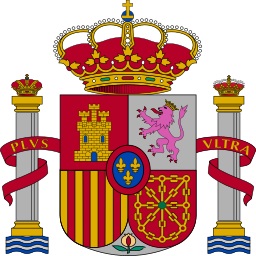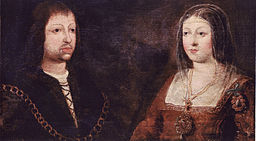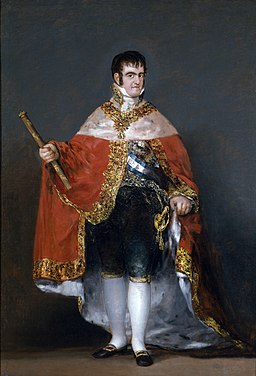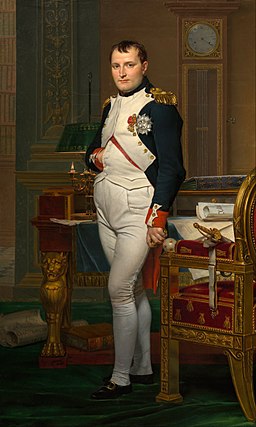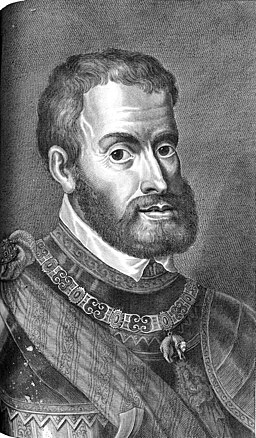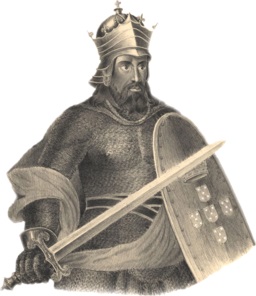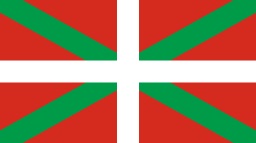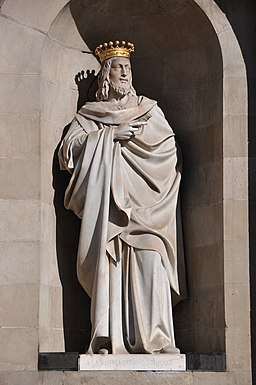The Regions of Spain
Aragon
Aragon is a region of northeastern Spain on the Iberian peninsula. Aragon has a proud cultural heritage and its own unique language, Aragonese. In 1137, the regions of Aragon and Catalonia united to form the Crown of Aragon, whose illustrious line of kings led the reconquest of the eastern peninsula from the Muslims. The Crown of Aragon extended its Mediterranean empire with the recapture of Mallorca in 1229 and Sicily in 1282 and it remained an important power throughout the Middle Ages. In 1469, King Ferdinand of Aragon married Isabella of Castile and this union brought together the two most powerful kingdoms of Spain. This marriage was essential for the eventual united Spanish nation, known as the Kingdom of Spain.[2]
By 1590, the Spanish monarchy was extremely powerful, therefore tension began to grow between the Spanish Monarchy and the other Spanish regions. Under the leadership of Miguel Primo de Rivera, Prime Minister of Spain from 1923 until 1930, Aragon experienced an economic boom. In June of 1936, the possibility of Aragon becoming a self-governing state was presented; however, the Spanish Civil War (1936-1939) prevented this from happening.[4]
From 1936 to 1939, Aragon was divided into two sides, the East and the West. The East side was controlled by the Republican Regional Defence Council of Aragon and the West side was controlled by the Nationalists. The Second Spanish Republic was defeated in April 1939, therefore Aragon and the rest of Spain were run by the Francoist dictatorship from 1939 to 1975.
Asturias
Asturias, which was the region of northern Spain and the birthplace of the Christian Reconquest of Spain from the Muslims. Asturias, which has a long and noble history, was colonized by the Romans who discovered Asturias to be rich in mineral deposits, particularly silver. The Romans established villas and towns, but the region was never completely Romanized. By the 7th century, Asturias had accepted Visigothic rule, and after the defeat of the last Visigothic king, Roderic, and the Arab invasion of 711, it became a refuge for Visigothic nobles.
They formed a court and elected the first King of Asturias, Pelayo, in 718. Very soon afterward Pelayo organized a concerted resistance to the Muslim invaders, and won the first battle of the Christian Reconquest, at Covadonga. In the 10th century, under King Alfonso III, Asturias included most of Galicia and some of the Basque country. However, Asturias was eclipsed by the rise of the Kingdom of Leon and Castile in the 10th century and it eventually became politically dependent on Leon.
Ferdinand VII of Spain abdicated the throne in 1808 during the Napoleonic Wars (1803-1815), which led to Asturias being the first Spanish province to rise up against the French. The riots began in May of 1808 and they officially declared war on Napoleon.[6]
Asturias became an autonomous community on December 30, 1981, with Rafael Luis Fernandez Alvarez as the first President of the Principality of Asturias.
Castile
At first, Castile was an eastern county of the Kingdom of Leon. Castile was an important Christian kingdom of medieval Spain, especially during the 800 year Christian Reconquest of Spain, when the Spanish overturned Muslim rule.[8]
In 1085 New Castile separated from Leon and became one of the crown's territories, but by 1230 Castile and Leon were reunited. When Ferdinand II of Aragon married Isabella I of Castile in 1469, Aragon and Castile were united and this would eventually lead to the creation of the Kingdom of Spain in 1516, when Charles V, their grandson, ascended both thrones. [2]
Galicia
Galicia, which was located in the northwestern region of the Iberian peninsula. Galicia is a region of Spain that has a unique cultural and linguistic heritage. In medieval times, the Celts and the Swabians, who were a Germanic tribe, settled this territory. Galicia was one of the most important Christian kingdoms of medieval Spain. [10]
Galicia was one of the most important Christian kingdoms of medieval Spain. In 1139, Galicia was divided into two territories and the southern half, called Portugal, became an independent kingdom under King Afonso I. Galicia remained within the Castilian sphere of influence after Portugal separated. During the later Middle Ages, Galicia declined in power as Castile became predominant, but the unique Galician culture and language continue to this day.
The Basques
The Basque country of northern Spain, located along the north coast of Spain, next to the western Pyrenees. The Basques, who are a pre-Roman people, have a proud and unique cultural heritage and language. The origins of the Basques remains shadowed in uncertainty although historians have attempted to link the Basques with Irish Celts, eastern European tribes or even North African peoples. The Basques were the last of the Pre-Roman tribes of Spain to accept Roman culture, laws and languages. However, they revealed no signs of Visigoth or Frankish culture.
The Basques remained distinct even after the Arab invasion of 711 because they took refuge in the valleys of the western Pyrenees and waited out the early wave of Arab conquest. As the Christian Reconquest that was launched by Asturias gathered momentum, the Basques became allied with Asturias and Navarre. In 778, Charlemagne entered Spain and sacked the city of Pamplona. In revenge, the Basques attacked and annihilated his forces as they were retreating through the Pyrenean mountain pass of Roncesvalles.
These events have been immortalized in the French epic poem "Chanson de Roland". After the 9th century, the Basques were politically aligned with a succession of kingdoms: Asturias, Navarre, and later Castile. Since the end of the Middle Ages and until today, the region was politically dependent on Castile. Nevertheless, the Basque language has never been lost and it is the symbol of this ancient culture that has survived so many centuries of contact and assimilation with other linguistic groups.
Valencia
Valencia, which is a region located on Spain's eastern Mediterranean coast, colonized and was developed as a port region by the Romans. It was distinguished by its proud heritage and tremendous cultural diversity. It thrived for centuries, but by 713 Valencia was completely under Muslim rule and the city became a staging point for raids further north and west into Christian Spanish lands. Rodrigo D¡az "El Cid" reconquered Valencia from the Muslims in 1094, but after his death in 1099 the Christians could not hold the city.
Valencia remained in Muslim hands from 1102 until 1238, when the armies of King James I of Aragon and Catalonia, "The Conqueror", claimed it once and for all for the Christians. This initiated a cultural and linguistic relationship between Catalonia and Valencia that continues to this day.
References
- ^ "File:Escudo de España (mazonado).svg." Wikimedia Commons, the free media repository. 7 Oct 2019, 19:06 UTC. https://commons.wikimedia.org/w/index.php?title=File:Escudo_de_Espa%C3%B1a_(mazonado).svg&oldid=369764913
- ^ Payne, Stanley G. A History of Spain and Portugal. Penguin Books, 1960.
- ^ "File:Ferdinand of Aragon, Isabella of Castile.jpg." Wikimedia Commons, the free media repository. 3 Oct 2019, 09:12 UTC. https://commons.wikimedia.org/w/index.php?title=File:Ferdinand_of_Aragon,_Isabella_of_Castile.jpg&oldid=369188197
- ^ Storrs, Christopher. The "Decline" of Spain in the Seventeenth Century. Cengage Learning EMEA Ltd., 2011.
- ^ "File:Francisco Goya - Portrait of Ferdinand VII of Spain in his robes of state (1815) - Prado.jpg." Wikimedia Commons, the free media repository. 28 Jan 2020, 19:01 UTC. https://commons.wikimedia.org/w/index.php?title=File:Francisco_Goya_-_Portrait_of_Ferdinand_VII_of_Spain_in_his_robes_of_state_(1815)_-_Prado.jpg&oldid=390659467
- ^ Oman, Charles. A History of the Peninsular War. Clarendon Press, 1902.
- ^ "File:Jacques-Louis David - The Emperor Napoleon in His Study at the Tuileries - Google Art Project.jpg." Wikimedia Commons, the free media repository. 15 Dec 2019, 07:19 UTC. https://commons.wikimedia.org/w/index.php?title=File:Jacques-Louis_David_-_The_Emperor_Napoleon_in_His_Study_at_the_Tuileries_-_Google_Art_Project.jpg&oldid=380412048
- ^ Martínez Díez, Gonzalo. El Condado de Castilla (711-1038) - La Historia Frente a la Levenda. Marcial Pons, Ediciones de Historia, 2005.
- ^ "File:Portrait of Holy Roman Emperor Charles V (Hazart).jpg." Wikimedia Commons, the free media repository. 1 Nov 2018, 23:57 UTC. https://commons.wikimedia.org/w/index.php?title=File:Portrait_of_Holy_Roman_Emperor_Charles_V_(Hazart).jpg&oldid=326163856
- ^ Encyclopedia Britannica; Or A Dictionary of Arts, Sciences, and Miscellaneous Literature. Archibald Constable, 1823.
- ^ "File:Afonso I de Portugal.png." Wikimedia Commons, the free media repository. 11 Dec 2015, 04:56 UTC. https://commons.wikimedia.org/w/index.php?title=File:Afonso_I_de_Portugal.png&oldid=181580756
- ^ "File:Flag of the Basque Country.svg." Wikimedia Commons, the free media repository. 6 Jan 2020, 20:46 UTC. https://commons.wikimedia.org/w/index.php?title=File:Flag_of_the_Basque_Country.svg&oldid=385905985
- ^ "File:Barcelona (Plaça de Sant Jaume) City Hall. Neoclassical facade. Statue of King James I the Conqueror. 1841-1844. Josep Bover, sculptor (29432296700).jpg." Wikimedia Commons, the free media repository. 4 Jan 2017, 09:09 UTC. https://commons.wikimedia.org/w/index.php?title=File:Barcelona_(Pla%C3%A7a_de_Sant_Jaume)_City_Hall._Neoclassical_facade._Statue_of_King_James_I_the_Conqueror._1841-1844._Josep_Bover,_sculptor_(29432296700).jpg&oldid=228609046
- ^ Swyrich, Archive materials
